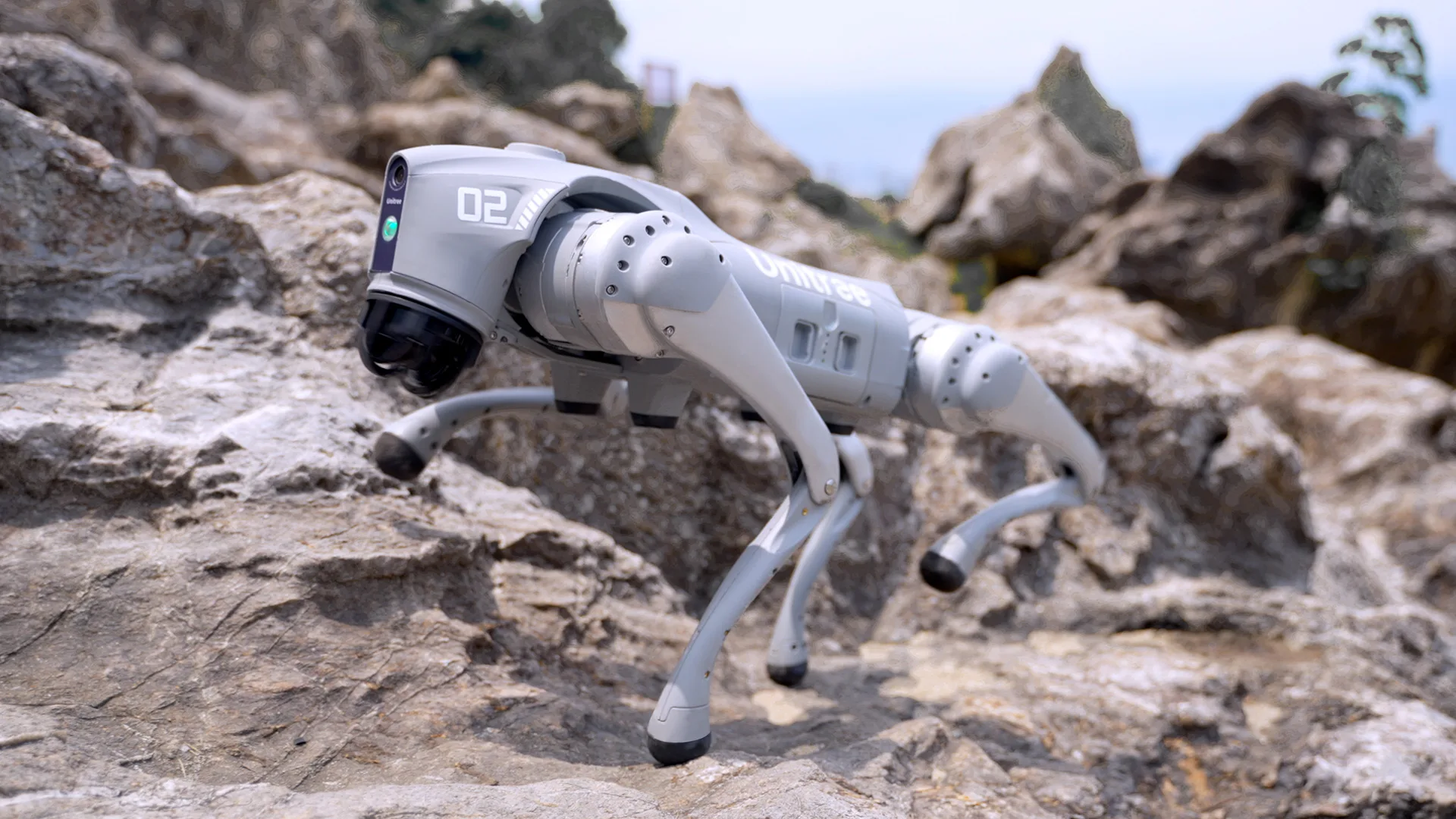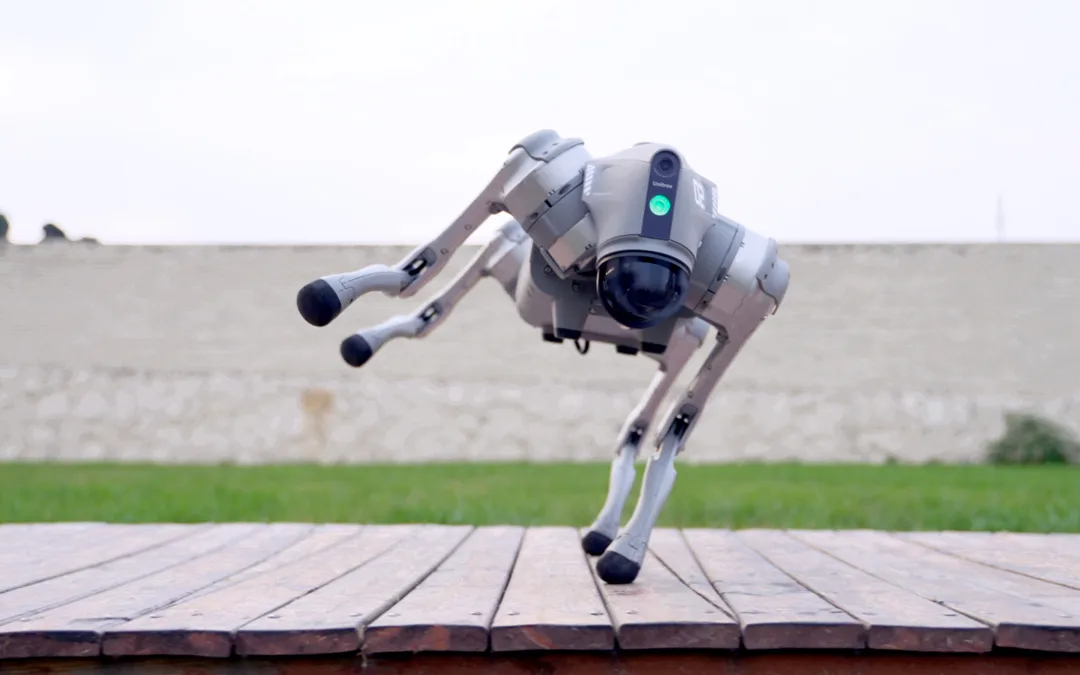By Scott Simmie
When people think of robots, they often picture industrial robotic arms doing repetitive work on assembly lines: Precision welding, picking and placing objects – those sorts of applications. Or perhaps a wheeled platform carrying a load from one location in a factory to another.
In recent years, however, new algorithms and technologies have led to an increase in the number of quadruped robots. These are the four-legged devices that inevitably remind observers of dogs, since they have roughly the same shape and move with a similar gait. They’re also (depending on the robot) roughly the same size as medium to large dog breeds.
The most well-known of these is likely Spot, built by Boston Dynamics. Built primarily for industrial inspections, this machine has also taken the spotlight (excuse the pun) with choreographed performances with the likes of Cirque du Soleil.
In fact, videos of Spot dancing proved so viral that Boston Dynamics produced a video to clarify that its robot is capable of much more:
THE QUADRUPED ADVANTAGE
Why four legs? Why not just wheels, like most mobile robotic platforms?
Good question. And we put that to InDro Robotics Account Executive Luke Corbeth.
“In most predictable environments, wheels or tracks will suffice,” he says.
“Quadrupeds excel at unpredictable terrain. You can start looking at complex infrastructure like refineries, where there might be stairs or pipes that need to be stepped over. Quadrupeds are also suitable for Search and Rescue, where there might be rubble on the ground or potentially unsafe conditions. Robots like these are very good at navigating terrain that would be impossible for a robot with wheeled or tracked locomotion.”
UNITREE
Unitree Robotics is one of a small but growing number of firms specializing in these robots. Its founder is Wang Xinxing, an engineer who started working on quadrupeds roughly a decade ago at Shanghai University. He built his first quadruped, XDog, by designing and building virtually everything, including motor drive boards, the master-slave architecture, the legs – and more.
All that hard work led to the founding of Unitree in 2016. And Wang and his team of engineers have never stopped trying to push the envelope. As the Unitree website explains, the company puts a heavy emphasis on R&D:
“Unitree attaches great importance to independent research and development and technological innovation, fully self-researching key core robot components such as motors, reducers, controllers, LiDAR and high-performance perception and motion control algorithms, integrating the entire robotics industry chain, and reaching global technological leadership in the field of quadruped robots. At present, we have applied for more than 150 domestic patents and granted more than 100 patents, and we are a national high-tech certified enterprise.”
We’re going to explore two new models from Unitree in just a moment, but it’s worth taking a look back at the early days. This video was uploaded seven years ago – after XDog was already in development for more than a year.
THE GO2
One of the new Unitree quadrupeds is the GO2. This is a step up from the GO1 EDU, which has been popular for research and development, corporate innovation parks, and even entertainment. (Yes, like Spot, the GO series can also dance – but they also do *much* more than that.)
The GO2 is a significant redesign from the GO1 series. Unitree has dropped some of the multiple cameras from the GO1 and developed its own LiDAR module, called the L1. It features a 360° x 90° hemispherical capture. With a minimal blind spot, Unitree says the GO2 is 200 per cent better at recognizing its surroundings than the GO1 series. It can detect surroundings as close as .05m away.
Because of the LiDAR, it’s obviously capable of mapping even unfamiliar surroundings and avoiding obstacles, meaning it’s perfect for Simultaneous Localization and Mapping (SLAM) applications. In conjunction with that LiDAR, the GO2 features the new NVIDIA Orin Nano for powerful onboard AI-enhanced EDGE computing
“From my experience, the LiDAR does a much better job at SLAM than the depth cameras on the previous models,” says Corbeth. “The obstacle avoidance is really good out-of-the-box and it can obviously be improved on with development (GO2 is Open Source). And the Orin is a really notable upgrade when it comes to computing power.”
INTERNAL AND EXTERNAL AI
One of the more intriguing features is that the GO2 is integrated with Chat GPT and can respond to voice commands. You could ask it to explain Einstein’s Theory of Relativity and it would speak the answer to you. More useful, though, is that you can instruct the GO2 to carry out certain tasks by voice.
“If you say: ‘Hey, go back to where I first turned you on,’ then it’s going to return home. So that’s a practical use. This is one of the first robots that can accept voice commands out-of-the-box and literally action some of those voice commands.”
You can even ask GO2, viat Chat GPT, to generate code for new tasks. Think about that for a moment.
It’s also capable of wireless charging. The GO2 can rest itself on a small optional pad and be ready for its next mission without human intervention. There’s also an option for a servo arm if a manipulator is useful for your application. It’s faster than the GO1 EDU, capable of trotting along at 5 metres/second. The GO2 also has a significantly longer run time – between two and four hours, depending on how strenuously it’s working. Battery capacity and endurance have jumped by 150 per cent compared to the previous model.
“The locomotion – their internal algorithm for how the robot moves – is much improved. So it can go faster, it’s more reliable, it’s quieter,” adds Corbeth. Firmware upgrades are OTA (over the air), with user authorisation. The GO2 connects via 4G, Wi-FI6 and Bluetooth.

USE-CASES
Though the GO2 could be used for basic industrial applications, it’s intended more for R&D and education (there’s even the option of drag-and-drop block coding). InDro Robotics is also capable of modifying the robot with our InDro Backpack – which enables data-dense 5G operation with an easy-to-use dashboard and comprehensive documentation. The Backpack also contains USB slots for additional sensors, as well as the Robot Operating System (ROS) code necessary for seamless integration.
“Anything the GO1 could do, the GO2 can do better, faster, longer,” says Corbeth.
There are even variants available – the GO2 Enterprise and GO2 Enterprise Plus – with some additional bells and whistles intended for law enforcement, Search and Rescue and other First Responder applications. Those features include dual backup communication links, a searchlight and emergency flashing lights, an additional camera and the ability for two-way voice communication.
Here’s a look at the basic GO2 in action:
THE BIG DOG
Unitree’s other new quadruped is the B2. It’s an incredibly powerful, enterprise-level machine that can be deployed in even the most demanding conditions. Use-cases include:
- Industrial asset monitoring and surveillance
- Search and Rescue/First Responder work
- Carrying heavy payloads/cargo over even rough terrain
- Working in water (Ingress Protection rating IP67)
Capable of moving at 6 metres per second (21.6 km/hour), Unitree says the B2 is the world’s fastest enterprise-level quadruped.
“That’s really fast – like ridiculously fast,” says InDro’s Corbeth.
“The B2 is designed less for development and more for real commercial applications. It’s also Open Source, which differentiates it from quadrupeds like Spot, or those made by Ghost Robotics, ANYmal, etc. So we have the option to deploy proprietary software on it that we’ve built and designed, or our partners have built and designed.”
Like its predecessor the B1, the size of the B2 is striking. It weighs 60 kg and measures 1098mm x 450mm x 645mm.

INDUSTRY-READY
Straight from the box, the B2 is ready for a variety of use-cases. With strength and endurance, this machine has been tested carrying a 45 kilogram load 7.98 kilometres on a single charge (or 20kg more than 15 km). If it’s not carrying a load, it can walk more than 20 kilometres non-stop.
The B2 can handle slopes of 45° with ease, even in rough terrain. It can even walk on greasy or oil-covered floors without falling down. (You’ll see an impressive demo involving banana peels shortly.)
Unitree has measured a 170 per cent improvement in joint performance over the B1, with 360 Nm (Newton-metres, or 265.5 foot-pounds) of torque. Run-time is vastly improved, with the B2 capable of operating between four and six hours on a mission (depending on terrain, payload and speed). The heavy-duty battery is designed for rapid swapouts, and the option of autonomous wireless charging via pad is an option.
From the factory, the B2 is equipped with a 32-wire automotive-grade LiDAR, two depth cameras, a high-resolution optical camera, and a high-capacity 45Ah (2250Wh) battery.
“And the B2 can be further customized, either directly from the factory or by InDro Robotics for specific use-case scenarios,” says Account Executive Corbeth. “We can integrate additional sensors, including thermal and even gas-detecting modules according to client needs. And, of course, we can also outfit the B2 with the InDro Robotics Backpack, which enables 5G operation and allows for rapid integration of additional sensors.”
All of those are great options to have, but Corbeth emphasizes “this quadruped is also capable of starting work straight out of the box.”
BUILT TOUGH
Make no mistake. This robot has been built to thrive in punishing conditions, including operating in water. It’s also very strong, capable of bearing a load of 120kg while standing. Control and perception are managed by multiple processors, including an NVIDIA Jetson Orin NX, three Intel Core i7s and an Intel Core i5. (These can vary if you’re looking for a custom factory build.) Plus, of course, InDro has expertise in modifying all of the Unitree quadrupeds pending client needs.
“InDro Robotics does have the ability to outfit these with any sensors that aren’t standard from Unitree,” explains Corbeth.
Plus, there’s also the option of wheels. The lower legs can be swapped out with wheeled versions. If the B2 is operating on flat terrain these are more efficient than walking.
“This option combines the best of both worlds between a legged and a wheeled robot – you get the speed and efficiency of a wheeled robot, yet with the other legs it can also climb stairs and manage rubble or other obstacles on the ground,” he adds.
And how does this new machine compare to the competition? Unitree says its measured parameters are superior – and there’s agreement from Corbeth.
“Compared with Spot, ANYmal and Ghost Robotics, I think we’re very competitive on the hardware side. I actually think Unitree has got to the point hardware-wise where it’s now superior to pretty much all the other options.”
INDRO’S TAKE
As a North American distributor for Unitree, we obviously have faith in their products. We’ve also been partnered long enough to see the company’s commitment to continuously and meticulously advancing its products. These are excellent and durable quadrupeds, as our many clients will attest.
InDro also takes pride in supplementing Unitree’s documentation to get clients up and running quickly, and on those rare occasions when something goes wrong – we know how to repair them.
“Unitree is quickly becoming a world leader in the quadruped sector,” says InDro Robotics CEO Philip Reece.
“The new models are exceptionally well-built, with significant gains in power, run-time and processing abilities. Plus, add-ons like the InDro Backpack make these quadrupeds even more versatile for virtually any use-case scenario.”
Interested? Get in touch with us HERE to arrange a demo.

